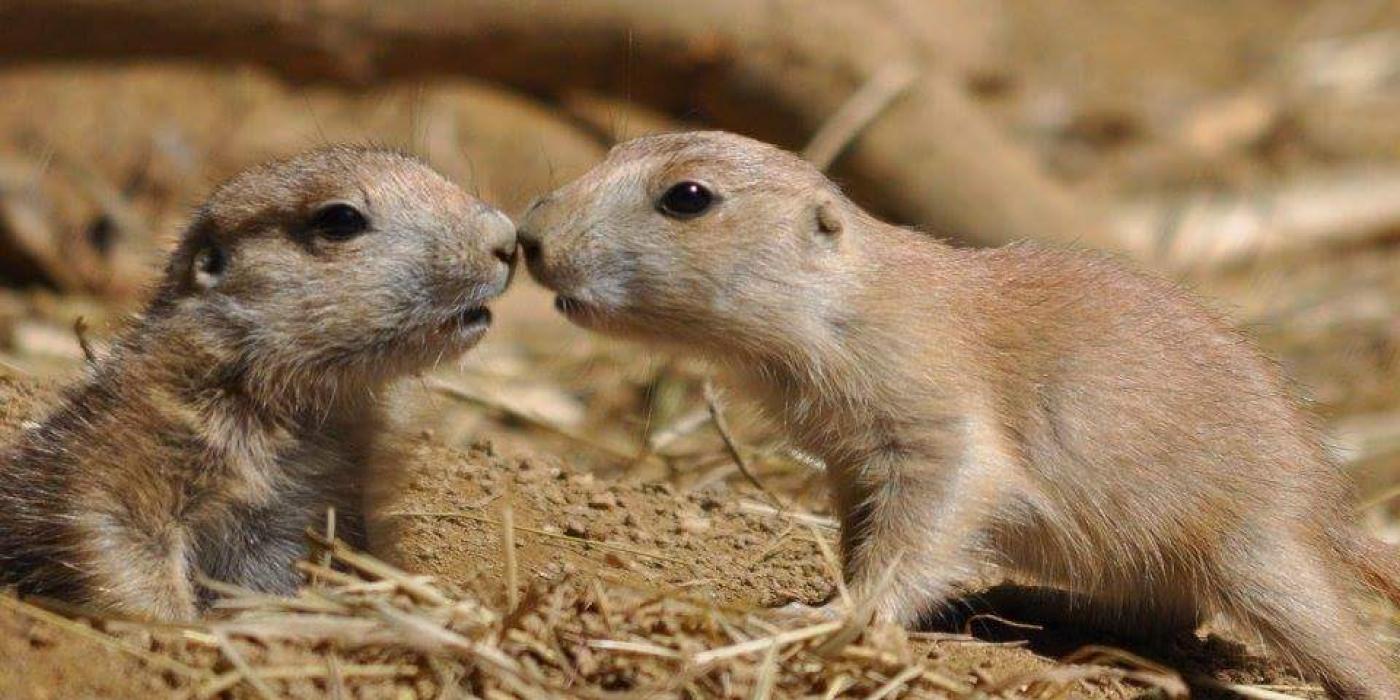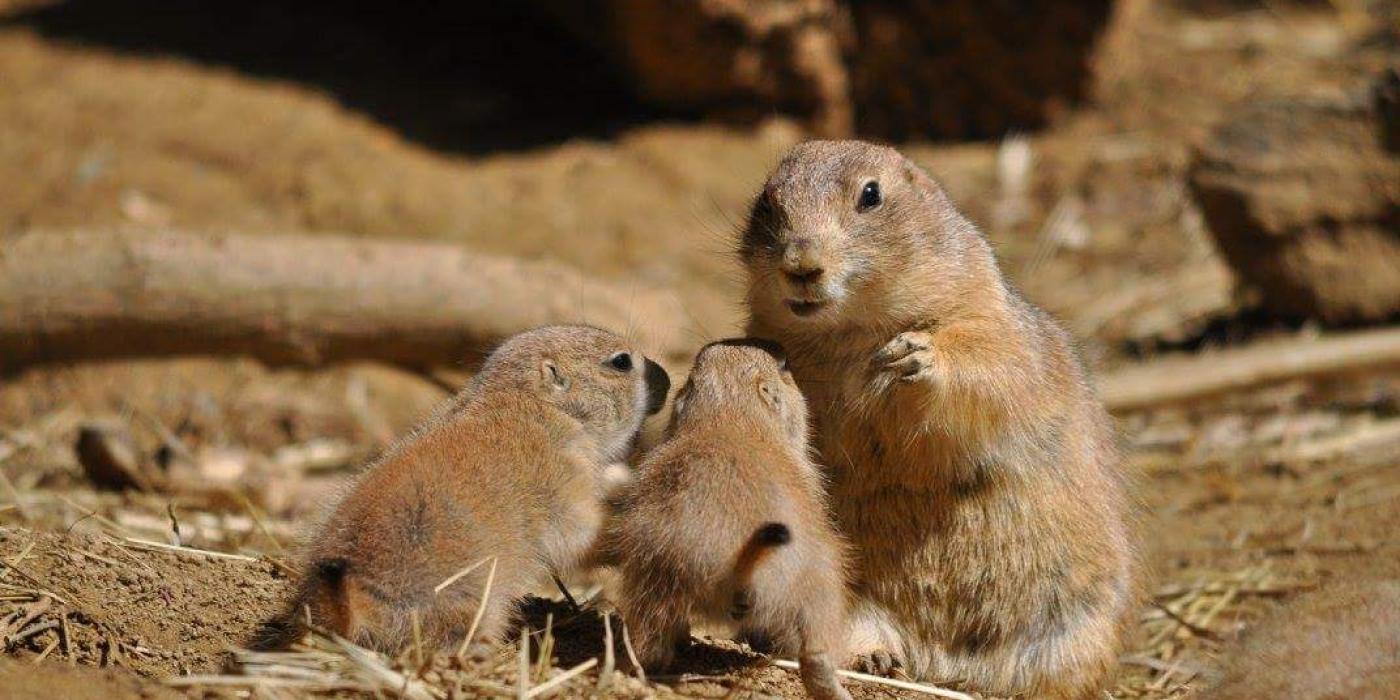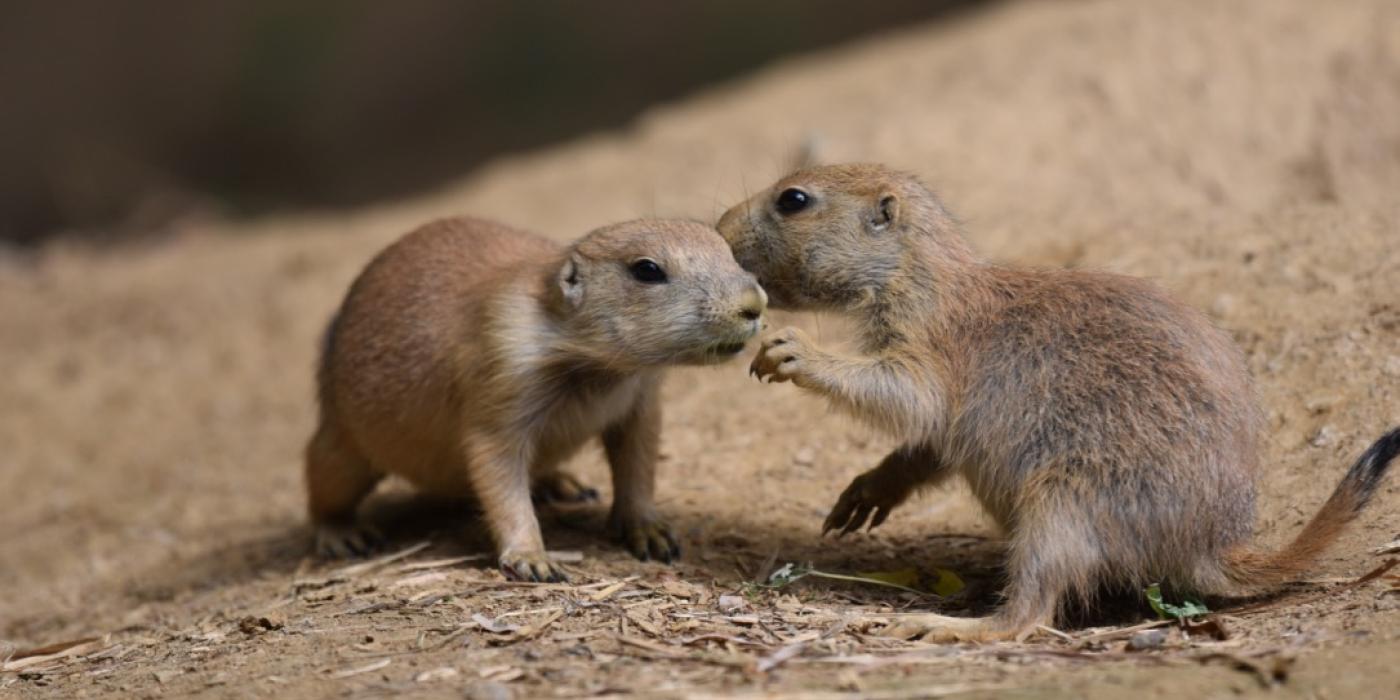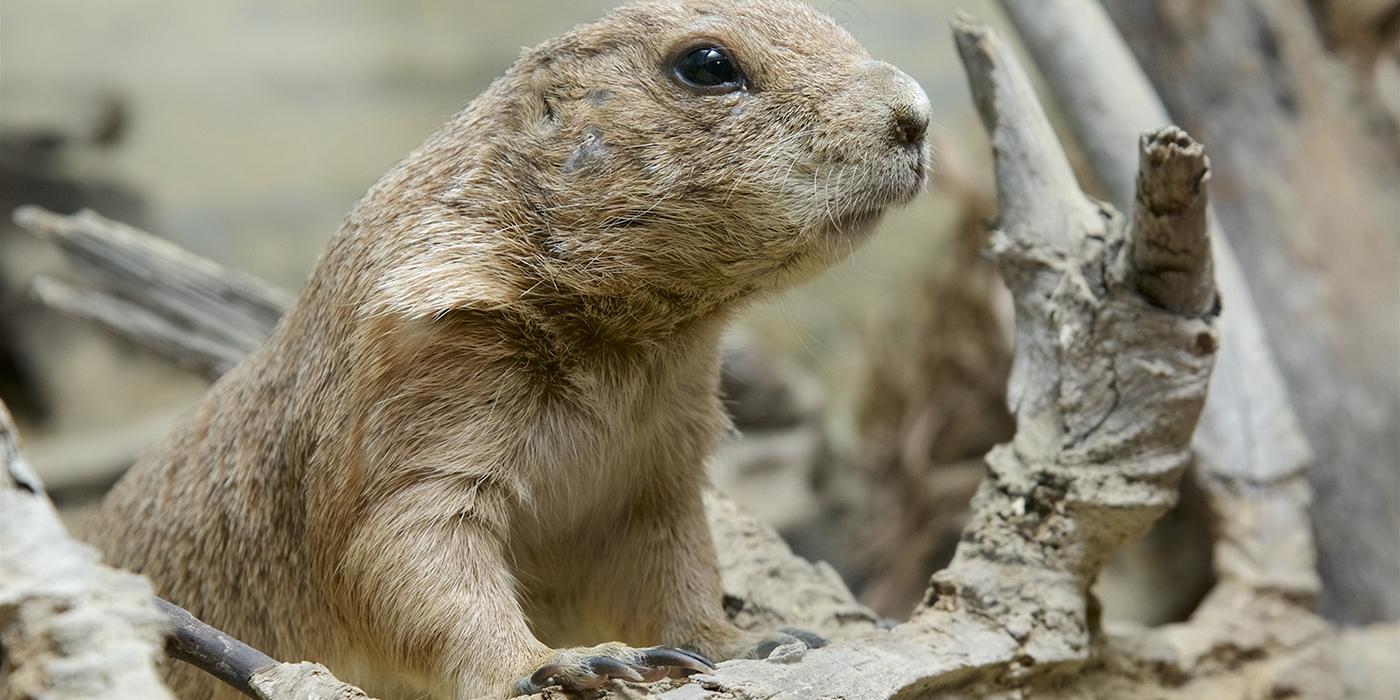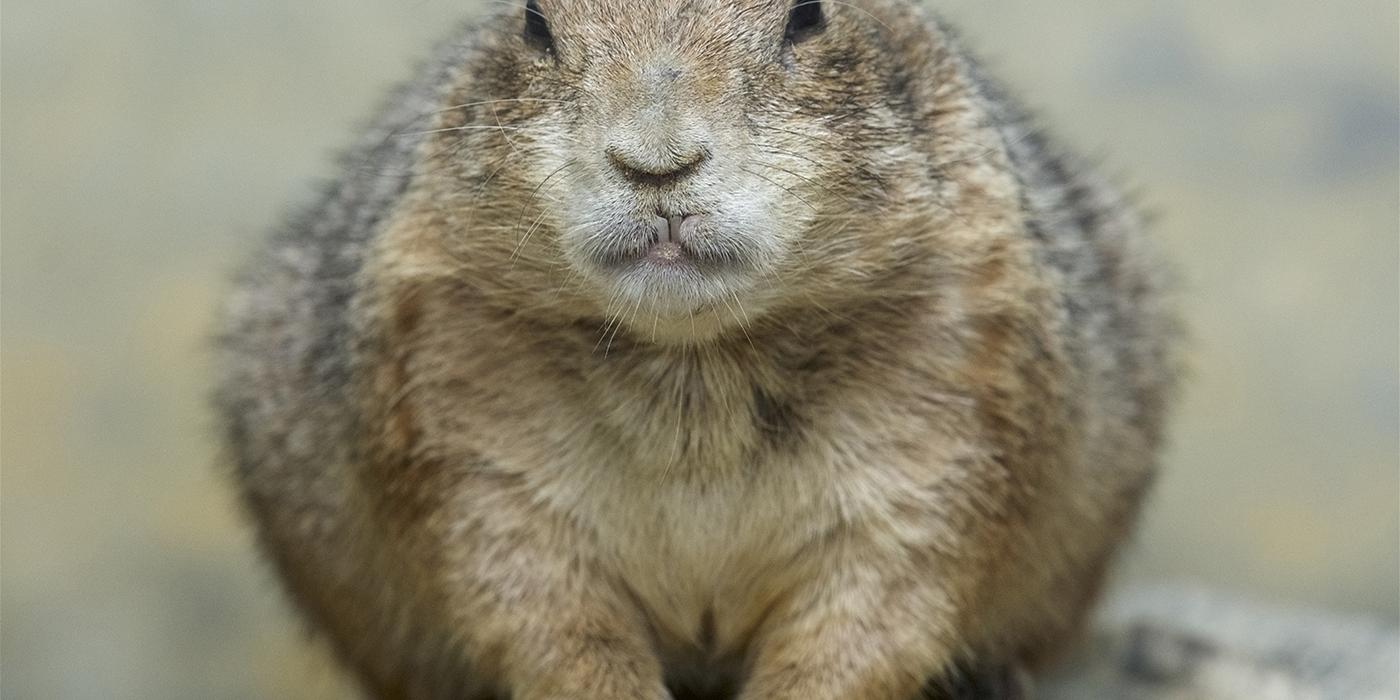Physical Description
Black-tailed prairie dogs are tan with a whitish or buff-white belly. The tips of their tails are sparsely covered by black hair. They have short ears and, compared to their body size, relatively large black eyes.
Size
They measure 14 to 17 inches (36 to 43 centimeters) long and weigh between 2 and 3 pounds (1 kilogram).
Native Habitat
Black-tailed prairie dogs are found on the Great Plains east of the Rocky Mountains from Saskatchewan to Sonora and Chihuahua in Mexico.
Prairie dog habitats are traditionally dry, flat, sparsely vegetated grasslands. Prairie dogs prefer fine or medium textured soils, as these work best for building underground burrows.
Like beavers, black-tailed prairie dogs are habitat modifiers who will dig burrows close together to form colonies, called towns.
Black-tailed prairie dog burrows are usually U-shaped with chambers connected by tunnels, and can go 7 to 15 feet (2 to 4.5 meters) deep. Throughout the town, they cut down anything growing taller than about 6 inches (15 centimeters), which allows the prairie dogs to better see predators. The mound of earth at the entrance of burrows helps to keep the burrows from flooding. Multiple entrances allow for an escape route in the event a predator gets into the burrow. The nesting chamber is near the bottom of the burrow and has dry, grass bedding. There are listening chambers located near the entrance of the burrow, which allow prairie dogs to listen for potential predators before leaving the safety of the burrow.
On average, colonies span less than half of a square mile (1.3 square kilometer).
Lifespan
The lifespan in the wild for black-tailed prairie dogs is up to 8 years for females, and around 5 years for males. However, around half of prairie dogs in the wild do not survive their first year of life due to high rates of predation. Prairie dogs in human care can live over 8 years.
Communication
Prairie dogs exhibit a broad range of vocalizations, and there is some evidence of variation in the basic sound used to identify different types of predators. Chirks are alarm calls, which usually sounds like "chirk-chirk-chirk." A jump-yip is a strong arch of the back followed by a shrill yip. This occurs when a predator leaves the area, or can be used in territorial displays
Food/Eating Habits
Grasses and leafy vegetation make up 98 percent of the diet for black-tailed prairie dogs. They occasionally eat grasshoppers, cutworms, bugs and beetles. Their primarily herbivorous diet provides all of the moisture content that they need—these prairie dogs do not need to drink water.
Leafy greens, root vegetables, herbivore pellets, hay and grass (when available) make up the diet of black-tailed prairie dogs at the Zoo.
Sleep Habits
Primarily crepuscular (active at dusk and dawn) during warmer months, black-tailed prairie dogs spend most hot summer days sleeping and are active above ground in the morning and evening. In cool or overcast weather, prairie dogs may remain above ground all day. They emerge shortly after sunrise and return to the burrow around sunset. Rain will often drive them to retreat underground.
Social Structure
Black-tailed prairie dogs are social animals that live in towns, or colonies, which are further divided into familial neighborhoods, or coteries. The number of prairie dogs in each town can fluctuate, but will normally amount to 12 individuals per 2.5 acres (1 hectare). These family groupings are made up of one male, one to four females, and their young of up to 2 years of age. Young, male prairie dogs will usually migrate to another colony when they mature, and will seldom start up their own colony.
Within each coterie, individual black-tailed prairie dogs have specific activities to perform. A typical day is divided between foraging, interacting with others, maintaining burrows and scouting for predators. One prairie dog acts as the sentinel, standing on the mound and watching for predators. If danger is detected, the "look-out" will warn other colony members by emitting a series of bark-like whistles before retreating to the safety of his burrow.
Reproduction and Development
Black-tailed prairie dogs reach sexual maturity by two years of age. They breed once a year; the timing depends on the location of the population (ranging from January to March). Mating often takes place underground, and gestation lasts around 30 days. Litter size is between two and eight pups on average. Pups are born blind, naked and mostly helpless. Both sexes help rear the young, which require a large investment by parents in order to ensure their survival. Males help protect pups within their coteries by defending against strange males. The bulk of parental care is provided by females, who nurse, groom and protect their offspring. Infanticide is common, so young are very vulnerable before leaving the burrow. Once the pups have emerged above ground, they will nurse and be accepted by any lactating female.
Conservation Efforts
Despite their conservation status, the loss of open prairie has dramatically reduced the prairie dog population. At the beginning of the twentieth century, prairie dogs occupied 100 million acres (40 million hectares) of Great Plains down the eastern side of the Rockies from Canada to Mexico. Today, that range has decreased to less than 2 million acres (766,400 hectares). Agriculture and urbanization are responsible for the drastic loss and fragmentation of prairie dog habitat.
Seen as pests, prairie dogs have been exterminated (via poisoning and shooting) because of the perceived competition with grazing cattle and bison for grasses. However, studies indicate that prairie dogs do not significantly affect the amount of vegetation available for cattle.
Black-tailed prairie dogs are also struggling against an inadvertently introduced disease called sylvatic plague. This infection is caused by a bacterium transmitted by fleas and can be very serious, able to kill over 99 percent of a colony. Despite the gravity of this plague, the U.S. Fish and Wildlife Service has concluded that prairie dogs are not significantly threatened because of their ability to recover their population, the high exposure needed to contract the disease and the range which the plague has spread.
Black-tailed prairie dogs are an umbrella and keystone species: they play an important role in the grassland ecosystem and their towns support a number of other species. Biologists count more than 170 vertebrate species affected by the prairie dogs' existence. One of their important roles is turning the soil; they bring the tunnel soil up to the surface and the tunnels aerate the ground. Scientists have learned that their grass clipping stimulates new growth and can raise the quality and diversity of the forage for other grazers. At the center of their towns, however, they have been known to kill off the grass, allowing broadleaf herbs and small shrubs to move in.
Other studies show that the density of wildlife tends to be greater around prairie dog towns than in expanses of prairie with no prairie dogs. The other species include mice, swift foxes, and raptors. Burrowing owls and prairie rattlesnakes rely on the burrows for shelter. Pronghorn deer seek out the broad leaf shrubs in the center of towns. Scientists have actually found that prairie dogs are often a symptom of overgrazing, as they do better in overgrazed areas. Before western expansion, prairie dogs followed the bison herds and founded their towns on the lands that had been grazed to the ground.
Unfortunately, sylvatic plague has the ability to kill over 99 percent of prairie dogs in a colony, which makes recovering infected populations incredibly difficult. Despite this, overall population numbers remain high. Prairie dog colonies are present in several protected areas where hunting/eradication measures are not allowed. Further population studies and inventories are needed, as is research into prairie dog genetics and habitat fragmentation between colonies.
Help this Species
- Support organizations like the Smithsonian’s National Zoo and Conservation Biology Institute that research better ways to protect and care for this animal and other endangered species. Consider donating your time, money or goods.
- Share the story of this animal with others. Simply raising awareness about this species can contribute to its overall protection.
